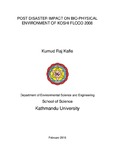Please use this identifier to cite or link to this item:
http://archive.nnl.gov.np:8080/handle/123456789/171| Title: | Post Disaster Impact on Bio-physical Environment of Koshi flood 2008 |
| Authors: | Kafle, Kumud Raj |
| Keywords: | Koshi River |
| Issue Date: | 24-Mar-2019 |
| Abstract: | The Koshi River is found to have shifted about 115 km westward due to sedimentation and tectonic activities in the past 200 years indicating the extent of damage caused in this region. The flood that occurred in 2008 is one of the most catastrophic events in last decade; it affected around 2.64 million people in total; and 60,000 people and 7000 ha. fertile land in the eastern lowlands of Nepal. The sediment deposited lands have become barren (as of July, 2015) which is 30% of the cultivated land in Shreepur, Haripur and western Kushaha VDC in Sunsari district. This thesis focuses on the impact of Koshi flood 2008 in terms of sedimentation in the affected area. Additionally, issues of epidemiology, vegetation reclamation and early warning system, which are interrelated with flooding, are also examined in this research. Because the thesis examines diverse but interrelated issues, multi-method approach combining field visits, sieve analysis, lab based experiment intertwined with field based observation, normalized differences of vegetation indices, questionnaire survey, was used. Field based study of the flooded area showed high variation in the thickness and size of the flood sediment. Based on the thickness, the affected area was divided into four zones, namely central red, red, yellow and green. Through the sieve analysis of the sediments, it was observed that the fineness is greater towards the green zone which is further away from other zones. The thickness varied from 0.10 m in green zone to 4.5 m in central red zones. The central red zone area, which is basically on the new channel area, had greater average thickness of 2.0 m. Crop yield for traditional crops is reported to have increased by 50%-75% in green zones than in other zones; and for cash crops, an increase of 200%-300% was reported. The study also found that the textures, composition, and thickness of the sediments determine the quality and quantity of agriculture production in sedimented land. The analysis of Normalized Differences of Vegetation Indices (NDVI) showed mean values changes of 45.73% and 29.36% during pre and post disaster phase in dry and wet seasons respectively. The average difference of mean NDVI (32.87%) and sum NDVI (29.57%) appeared similar in both the seasons. The analysis of vegetation reclamation showed the rate of reviving to be about 10% per year without intervention of technology. Health issues analyzed through public health data from local health posts and District Public Health Office (DPHO), and primary data collected through questionnaire survey, revealed about casualties as well as psycho-physical problems. It is found that the direct flood induced death was only two; other 39 deaths were reported within the four months of the disaster, mostly amongst those living in the rehabilitation camps. Infectious diseases and mental disorders are found as the major health issues during the post flood condition. The infectious diseases increased by 30% in the first year after the disaster, whereas mental disorder patients increased immediately and within one to three years of period from 22.7% to 29.3% . It was inferred that effectiveness of epidemiological intervention would be required continuously for up to two years after the flood. The study on effectiveness of media through questionnaire administered to stratified random sample showed that 77% respondents considered radio (85% FM radio) as the most effective means of communication for pre-disaster warnings. It is also found that the information disseminated at least 24 hours prior to the disaster would be ample for the people to manage comfortably even without the presence of government rescue agencies. The role of other media such as newspapers and television was not reported to be as effective as radio and phone text messages. |
| URI: | http://103.69.125.248:8080/xmlui/handle/123456789/171 |
| Appears in Collections: | 300 Social sciences |
Files in This Item:
| File | Description | Size | Format | |
|---|---|---|---|---|
| Final Thesis.pdf | 5.69 MB | Adobe PDF |  View/Open |
Items in DSpace are protected by copyright, with all rights reserved, unless otherwise indicated.